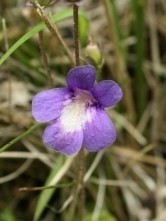Pinguicula grandiflora grandiflora
(Pinguicula grandiflora grandiflora)

Description
The Sierra Nevada tiraña (Pingguicola nevadensis) is a carnivorous plant, endemic to Sierra Nevada, Spain. It traps insects through its sticky leaves, using them as "fly traps", thus obtaining nutrients in an environment where they are not abundant; its flowers are purple-pink, usually blooming in July. It is listed as a vulnerable species, as sheep are subject to problems such as tourism, overgrazing and water scarcity. Its habitat is the Oro-Mediterranean and Cryo-Mediterranean flats, more specifically the sheep and peat bogs, in the most humid and flooded areas above 2,500 m asl (meters above sea level). Pinguicula, commonly known as the butterworts, is a genus of carnivorous flowering plants in the family Lentibulariaceae. They use sticky, glandular leaves to lure, trap, and digest insects in order to supplement the poor mineral nutrition they obtain from the environment. Of the roughly 80 currently known species, 13 are native to Europe, 9 to North America, and some to northern Asia. The largest number of species is in South and Central America. The majority of Pinguicula are perennial plants. The only known annuals are P. sharpii, P. takakii, P. crenatiloba, and P. pumila. All species form stemless rosettes. Butterworts can be divided roughly into two main groups based on the climate in which they grow; each group is then further subdivided based on morphological characteristics. Although these groups are not cladistically supported by genetic studies, these groupings are nonetheless convenient for horticultural purposes. Tropical butterworts either form somewhat compact winter rosettes composed of fleshy leaves or retain carnivorous leaves year-round. They are typically located in regions where water is least seasonally plentiful, as too damp soil conditions can lead to rotting. They are found in areas in which nitrogenous resources are known to be in low levels, infrequent or unavailable, due to acidic soil conditions. Temperate species often form tight buds (called hibernacula) composed of scale-like leaves during a winter dormancy period. During this time the roots (with the exception of P. alpina) and carnivorous leaves wither. Temperate species flower when they form their summer rosettes while tropical species flower at each rosette change.
Taxonomic tree:







